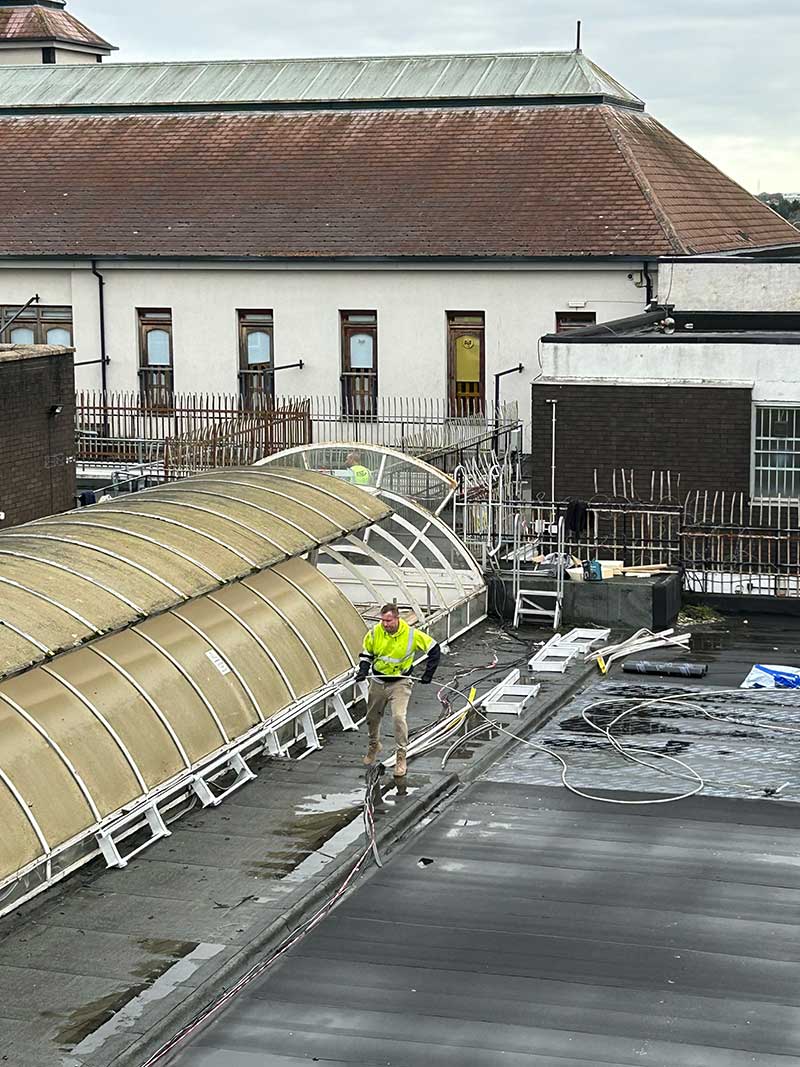
In the demanding world of industrial facility management, roof leaks often fall into the “we’ll get to it later” category. Amid pressing production schedules, equipment maintenance, and workforce management, a minor drip from above may not seem urgent. However, even the smallest roof leak can trigger a chain reaction of consequences that go far beyond a simple repair—impacting structural integrity, operations, and long-term profitability.
Structural Impacts Begin Immediately
When water enters an industrial facility through the roof, it doesn’t stay localized. Instead, it quietly spreads through the roofing system and building structure, causing damage that can escalate quickly.
Roof Deck Compromise
The roof deck—whether made of steel, wood, or concrete—provides foundational support. Prolonged exposure to moisture leads to corrosion, rotting, or structural weakening, all of which can endanger the entire system’s integrity.
Insulation Breakdown
Insulation is critical for maintaining energy efficiency and moisture control. Once it becomes saturated, it loses its effectiveness, fosters mold, and adds unnecessary weight to the roof. In many cases, full replacement is the only solution.
Roofing Membrane Degradation
When water gets beneath the waterproofing membrane, it can cause it to separate from the substrate. Freeze-thaw cycles, trapped moisture, and chemical degradation further accelerate wear and tear, often expanding the damage far beyond the original leak site.
Operational Disruption and Business Risk
Beyond physical damage, a leaking roof can cause major disruptions to your operations, with ripple effects across production, inventory, and workforce safety.
Production Downtime
Water intrusion in production areas may require equipment shutdowns, re-routing of operations, or even temporary plant closures. This creates delays, lost output, and unexpected inefficiencies.
Inventory Loss
Stored goods, raw materials, and finished products are highly vulnerable to water damage. Moisture can render packaging unusable, affect product quality, or spoil sensitive items—leading to avoidable write-offs and delivery issues.
Increased Energy Consumption
A compromised roof system reduces thermal efficiency, forcing HVAC systems to work harder to maintain consistent temperatures. This results in higher energy usage and increased strain on climate control infrastructure.
Long-Term Consequences Often Overlooked
Ignoring roof leaks doesn’t just create immediate problems—it invites long-term liabilities that can impact your facility’s financial health and compliance status.
Insurance Implications
Ongoing leaks that are not promptly addressed may lead to challenges with insurance claims. Insurers may limit coverage, increase premiums, or decline renewals if damage is deemed preventable or due to negligence.
Regulatory and Safety Risks
Moisture infiltration can trigger occupational safety concerns, environmental violations, and building code noncompliance. Issues like mold, water near electrical systems, or slip hazards can result in fines, shutdown orders, or liability claims.
Employee Health and Safety
Damp conditions foster mold and bacteria, compromise air quality, and create physical hazards. These conditions increase the risk of employee health issues, absenteeism, and even workers’ compensation claims.
The Case for a Proactive Approach
Addressing roof leaks as soon as they arise is not just a maintenance task—it’s a strategic decision that protects assets, maintains uptime, and reduces risk exposure. Facility managers can prevent major disruptions and expenses by establishing a proactive roof management program that includes:
-
Scheduled professional inspections twice a year, plus after major weather events
-
Regular in-house visual checks by maintenance staff
-
Pre-approved repair budgets for fast action
-
Relationships with trusted roofing contractors who specialize in industrial systems
-
Preventative maintenance during scheduled downtime
-
Moisture scanning technology to identify hidden issues before they become visible
-
Digital documentation of all inspections and repairs
Conclusion
What may seem like a small roof leak can quickly evolve into a serious threat to the structure, operations, and profitability of an industrial facility. By recognizing the hidden consequences and acting swiftly, facility managers can preserve both the physical condition of the building and the financial stability of the business.
In the complex environment of industrial maintenance, a proactive response to roof leaks stands as one of the smartest investments a facility can make.









